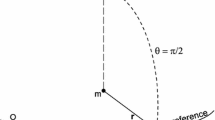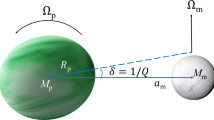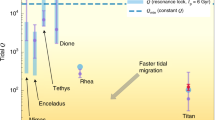Abstract
This paper deals with a new formulation of the creep tide theory (Ferraz-Mello in Celest Mech Dyn Astron 116:109, 2013—Paper I) and with the tidal dissipation predicted by the theory in the case of stiff bodies whose rotation is not synchronous but is oscillating around the synchronous state with a period equal to the orbital period. We show that the tidally forced libration influences the amount of energy dissipated in the body and the average perturbation of the orbital elements. This influence depends on the libration amplitude and is generally neglected in the study of planetary satellites. However, they may be responsible for a 27% increase in the dissipation of Enceladus. The relaxation factor necessary to explain the observed dissipation of Enceladus (\(\gamma =1.2{-}3.8\times 10^{-7}\ \mathrm{s}^{-1}\)) has the expected order of magnitude for planetary satellites and corresponds to the viscosity \(0.6{-}1.9 \times 10^{14}\) Pa s, which is in reasonable agreement with the value recently estimated by Efroimsky (Icarus 300:223, 2018) (\(0.24 \times 10^{14}\) Pa s) and with the value adopted by Roberts and Nimmo (Icarus 194:675, 2008) for the viscosity of the ice shell (\(10^{13}{-}10^{14}\) Pa s). For comparison purposes, the results are extended also to the case of Mimas and are consistent with the negligible dissipation and the absence of observed tectonic activity. The corrections of some mistakes and typos of paper II (Ferraz-Mello in Celest Mech Dyn Astron 122:359, 2015) are included at the end of the paper.







Similar content being viewed by others
Notes
This forced libration is related to the asymmetries of the tides raised on the body; it is different from the asymmetries resulting from the assumption of a permanent triaxiality of the body (see Frouard and Efroimsky 2017).
In paper II (Ferraz-Mello 2015), the variation of \(R_e\) has been neglected. However, when the equatorial prolateness varies due to a variation in the distance of m to M, the polar flattening and \(R_e\) vary accordingly: \(R_e \simeq R(1+\frac{1}{3}\epsilon _z)\) where R is the mean radius of the primary (constant).
The extension of the theory of papers I and II to the case in which the rotation is trapped in a periodic attractor is given in the Online Supplement linked to this paper.
The dissipation in each one of the two bodies may be considered separately. Within the order of approximation generally adopted (first order in the tidal deformations), the variation of the energy can be split into two parts, each one associated with the tidal deformation in one of the bodies while the other—source of the tidal potential—is kept as a mass point. Therefore, only the dissipation in one of the two bodies need to be explicitly considered.
It is worth stressing that we are referring to the actual energy of the system. At variance with it, the energy of the osculating Keplerian motion may vary (as well as the osculating semimajor axis) but such variation is only a consequence of the way in which osculating variables are defined.
According with the relation \(\gamma =wR/2\eta \) given in papers I and II (w is the specific weight at the surface of the body).
References
Archinal, B.A., Acton, C.H., A’Hearn, M.F., Conrad, A.: Report of the IAU working group on cartographic coordinates and rotational elements: 2015. Celest. Mech. Dyn. Astron. 130, 22 (2018)
Bĕhounková, M., Tobie, G., Choblet, G., Čadek, O.: Tidally-induced melting events as the origin of south-pole activity on Enceladus. Icarus 219, 655–664 (2012)
Boué, G., Correia, A.C.M., Laskar, J.: Complete spin and orbital evolution of close-in bodies using a Maxwell viscoelastic rheology. Celest. Mech. Dyn. Astron. 126, 31–60 (2016)
Brouwer, D., Clemence, M.: Methods of Celestial Mechanics. Academic Press, New York (1961)
Čadek, O., Souček, O., Bĕhounková, M., Choblet, G., Tobie, G., Hron, J.: Long-term stability of Enceladus’ uneven ice shell. Icarus 319, 476–484 (2019)
Choblet, G., Tobie, G., Sotin, C., Běhounková, M., Čadek, O., Postberg, F., Souček, O.: Powering prolonged hydrothermal activity inside Enceladus. Nat. Astron. 1, 841 (2017)
Correia, A.C.M., Boué, G., Laskar, J., Rodríguez, A.: Deformation and tidal evolution of close-in planets and satellites using a Maxwell viscoelastic rheology. Astron. Astrophys. 571, A50 (2014)
Correia, A.C.M., Ragazzo, C., Ruiz, L.S.: The effects of deformation inertia (kinetic energy) in the orbital and spin evolution of close-in bodies. Celest. Mech. Dyn. Astron. 130, 51 (2018)
Darwin, G.H.: On the secular change in the elements of the orbit of a satellite revolving about a tidally distorted planet. Philos. Trans. 171, 713–891 (1880). (repr. Scientific Papers, Cambridge, Vol. II, 1908)
Efroimsky, M.: Tidal dissipation compared to seismic dissipation: in small bodies, earths, and super-earths. Astrophys. J. 746, 150 (2012)
Efroimsky, M.: Tidal evolution of asteroidal binaries. Ruled by viscosity. Ignorant of rigidity, Astron. J. 150, 98 (2015) and Erratum: Astron. J. 151, 130 (2016)
Efroimsky, M.: Tidal viscosity of Enceladus. Icarus 300, 223–226 (2018)
Essén, H.: The physics of rotational flattening and the point core model. Preprint ArXiv 0403328v1,astro-ph.EP (2004)
Ferraz-Mello, S.: First-order resonances in satellite orbits. In: Ferraz-Mello, S. (ed.) Resonances in the Motion of Planets, Satellites and Asteroids, IAG-USP, pp. 37–52. (1985)
Ferraz-Mello, S.: Tidal synchronization of close-in satellites and exoplanets. A rheophysical approach. Celest. Mech. Dyn. Astron., 116, 109–140. (arXiv:1204.3957 astro-ph.EP ) (paper I) (2013)
Ferraz-Mello, S.: Tidal synchronization of close-in satellites and exoplanets: II. Spin dynamics and extension to Mercury and exoplanets host stars. Celest. Mech. Dyn. Astron. 122, 359–389 (2015). (arXiv:1505.05384 astro-ph.EP) (paper II)
Ferraz-Mello, S., Beaugé, C., Michtchenko, T.A.: Evolution of migrating planet pairs in resonance. Celest. Mech. Dyn. Astron. 87, 99–112 (2003)
Ferraz-Mello, S., Rodríguez, A., Hussmann, H.: Tidal friction in close-in satellites and exoplanets. The Darwin theory re-visited, Celest. Mech. Dyn. Astron., 101, 171–201 and Errata: Celest. Mech. Dyn. Astron. 104, 319–320 (2009).(arXiv:0712.1156 astro-ph.EP) (2008)
Folonier, H.A.: Tide on differentiated planetary satellites. Application to Titan. Ph.D. Thesis, IAG/University São Paulo (2016)
Folonier, H.A., Ferraz-Mello, S.: Tidal synchronization of an anelastic multi-layered satellite. Titan’s synchronous rotation. Celest. Mech. Dyn. Astron. 129, 359–396 (2017). (arXiv:1706.08603 astro-ph.EP)
Folonier, H.A., Ferraz-Mello, S., Kholshevnikov, K.V.: The flattenings of the layers of rotating planets and satellites deformed by a tidal potential. Celest. Mech. Dyn. Astron. 122, 183–198 (2015). (arXiv: 1503.08051 astro-ph.EP)
Frouard, J., Efroimsky, M.: Tides in a body librating about a spin-orbit resonance. Generalization of the Darwin-Kaula theory. Celest. Mech. Dyn. Astron. 129, 177–214 (2017)
Howett, C.J.A., Spencer, J.R., Pearl, J., Segura, M.: High heat flow from Enceladus’ south polar region measured using 10–600 cm\(^{-1}\) Cassini/CIRS data. J. Geophys. Res. Planets 116, id. E03003 (2011)
Iess, L., Stevenson, D.J., Parisi, M., Hemingway, D., Jacobson, R.A.: The gravity field and interior structure of Enceladus. Science 344(6179), 78–80 (2014)
Kamata, S., Nimmo, F.: Interior thermal state of Enceladus inferred from the viscoelastic state of the ice shell. Icarus 284, 387–393 (2017)
Kaula, W.M.: Tidal dissipation in the moon. J. Geophys. Res. 68, 4959–4965 (1963)
Kaula, W.M.: Tidal dissipation by solid friction and the resulting orbital evolution. Rev. Geophys. 3, 661–685 (1964)
Kopal, Z.: Gravitational heating of the moon. Icarus 1, 412–421 (1963)
Lainey, V., Karatekin, O., Desmars, J., Charnoz, S., Arlot, J.E., et al.: Strong tidal dissipation in Saturn and constraints on Enceladus thermal state from astrometry. Astrophys. J. 752(1), 14 (2012)
Le Gall, A., Leyrat, C., Janssen, M.A., Choblet, G., Tobie, G., et al.: Thermally anomalous features in the subsurface of Enceladus south polar terrain. Nat. Astron. 1, 63 (2017)
Lissauer, J.J., Stanton, J.P., Cuzzi, J.N.: Ring torque on Janus and the melting of Enceladus. Icarus 58, 159–168 (1984)
MacDonald, G.F.: Tidal friction. Rev. Geophys. 2, 467–541 (1964)
Meyer, J., Wisdom, J.: Tidal evolution of Mimas, Enceladus, and Dione. Icarus 193, 213–223 (2008)
Nakajima, A., Ida, S., Kimura, J., Brasser, R.: Orbital evolution of Saturn’s mid-sized moons and the tidal heating of Enceladus. Icarus 317, 570–582 (2018)
Neutsch, W.: On the gravitational energy of ellipsoidal bodies and some related functions. Astron. Astrophys. 72, 339–347 (1979)
Peale, S.J., Cassen, P.: Contribution of tidal dissipation to lunar thermal history. Icarus 36, 245–269 (1978)
Ragazzo, C., Ruiz, L.S.: Viscoelastic tides: models for use in Celestial Mechanics. Celest. Mech. Dyn. Astron. 128, 19–59 (2017)
Rambaux, N., Castillo-Rogez, J.C., Williams, J.G., Karatekin, Ö.: Librational response of Enceladus. Geophys. Res. Lett. 37, L04202 (2010)
Roberts, J.H., Nimmo, F.: Tidal heating and the long-term stability of a subsurface ocean on Enceladus. Icarus 194, 675–689 (2008)
Scheeres, D.J.: Stability in the full two-body problem. Celest. Mech. Dyn. Astron. 83, 155–169 (2002)
Segatz, M., Spohn, T., Ross, M.N., Schubert, G.: Tidal dissipation, surface heat flow, and figure of viscoelastic models of Io. Icarus 75, 187–206 (1988)
Shoji, D., Hussmann, H., Kurita, K., Sohl, F.: Ice rheology and tidal heating of Enceladus. Icarus 226, 10–19 (2013)
Spencer, J.R., Howett, C.J.A., Verbiscer, A., Hurford, T.A., Segura, M., Spencer, D.C.: Enceladus Heat flow from high spatial resolution thermal emission observations. EPSC Abstr 8, EPSC2013-840-1 (2013)
Spencer, J.R., Pearl, J.C., Segura, M., Flasar, F.M., Mamoutkine, A., Romani, P., Buratti, B.J., Hendrix, A.R., Spilker, L.J., Lopes, R.M.C.: Cassini encounters Enceladus: background and the discovery of a south polar hot spot. Science 311, 1401–1405 (2006)
Tajeddine, R., Rambaux, N., Lainey, V., Charnoz, S., et al.: Constraints on Mimas’ interior from Cassini ISS libration measurements. Science 346, 322–324 (2014)
Thomas, P.C., Tajeddine, R., Tiscareno, M.S., Burns, J.A., Joseph, J., et al.: Enceladus’s measured physical libration requires a global subsurface ocean. Icarus 264, 37–47 (2016)
Tisserand, F.: Traité de Mécanique Céleste, tome IV, chap. II. Gauthier-Villars, Paris (1891)
Vienne, A., Duriez, L.: TASS 1.6: Ephemerides of the major Saturnian satellites. Astron. Astrophys. 297, 588–605 (1995)
Wisdom, J.: Tidal dissipation at arbitrary eccentricity and obliquity. Icarus 193, 637–640 (2008)
Yoder, C.F., Peale, S.J.: The tides of Io. Icarus 47, 1–35 (1981)
Acknowledgements
We thank Gwenaël Boué and Michael Efroimsky for their detailed reading of the original manuscript and for their enlightening suggestions. We also thank C. Beaugé and G.O. Gomes for several discussions. This investigation is funded by FAPESP, Grants 2016/20189-9, 2014/13407-4, 2016/13750-6 and 2017/10072-0, and by the National Research Council, CNPq, Grant 302742/2015-8. Preliminary results of this investigation were presented at the 9th Humboldt Colloquium on Celestial Mechanics, in Bad Hofgastein (Austria), March 2017.
Author information
Authors and Affiliations
Corresponding author
Additional information
This article is part of the topical collection on Close Approaches and Collisions in Planetary Systems. Guest Editors: Rudolf Dvorak, Christoph Lhotka and Alessandra Celletti.
Electronic supplementary material
Below is the link to the electronic supplementary material.
Appendices
Appendix 1: Gravitational energy of an ellipsoid. Results after Essén (2004)
The gravitational energy of an ellipsoid of mass m and semi-axes \(a> b > c\) is explicitly given by
(Essén 2004) where the Taylor expansion of X around \(\xi = 1, \tau = 0\) is
and \(\xi \), \(\tau \) are functions of the flattening such that
Hence, to the first order,
and
The variation of the binding energy then is given by
Equation (44) agrees with the result of the direct integration showing that the difference between the binding gravitational energy of an ellipsoid and that of the corresponding sphere is of the order of the square of the flattenings \(\mathcal {E}_\rho , \mathcal {E}_z\).
It is worth mentioning that the alternative formulation due to Neutsch (1979) does not agree neither with the results of Essén (2004) nor with the results of a direct integration.
Appendix 2: Near-synchronous analytical approximation
In order to find an analytical approximation to the instantaneous flattenings \(\mathcal {E}_\rho ,\mathcal {E}_z\), the rotation angle \(\delta \) and the semidiurnal frequency \(\nu =2\varOmega -2n\) in the quasi-synchronous attractor, let us first consider a Keplerian motion for the companion M. Then, we consider the approximations:
Since, the rotation is quasi-synchronous, we may assume \(\delta \ll 1\). Hence
Introducing these approximations into the creep tide and torque equations, (7) and (17) (using that \(\nu =2\Omega -2n\), and \(\dot{\nu }=2\dot{\Omega }\)) and neglecting the term \({\dot{C}}{\varvec{\Omega }}\), we obtain
where \(\kappa =M/(M+m)\), and
It is important to note that both \({\overline{\epsilon }}_\rho \) as \({\overline{\epsilon }}_z\) are constants.
Let us assume the particular solution
the derivatives of which are
Finally, replacing (50) and (51) into the system (48), collecting the terms with same trigonometric argument and neglecting terms of higher order, we obtain
and
where \(\alpha =1-3\kappa \overline{\epsilon }_\rho \) and \(p=n/\gamma \). We mention that the mean values \(B_0,D_0,E_0,Z_0\) are given to the second order in eccentricity while the amplitudes \(B_i,D_i,E_i,Z_i\) (\(i\ne 0\)) are given to the first order in eccentricity.
Tidal forced oscillation of the semidiurnal frequency \(\nu \) (top left), of the orientation angle of \(\delta \) (top right), of the equatorial prolateness \(\mathcal {E}_\rho \) (bottom left) and of the polar oblateness \(\mathcal {E}_z\) (bottom right) of one body like Enceladus in function of the viscosity \(\eta \). The black solid lines are the limits of the oscillations and the mean values given by the numerical integration of Eqs. (7) and (17). The red dashed lines are the limits of the oscillations and the mean values given by the analytical approximation given by Eqs. (50), (52) and (53)
Figure 8 shows the comparison of the near-synchronous attractors as given by the complete nonlinear system defined by Eqs. (7) and (17) and the approximate analytical solution given above in the case of one body like Enceladus, in function of the viscosity \(\eta \). The dashed red lines show the maximum, minimum and mean values of \(\nu \), \(\delta \), \(\mathcal {E}_\rho \) and \(\mathcal {E}_z\) (from top left to bottom right) given by the approximate solution, while the solid black lines show the maximum, minimum and the mean values of \(\nu \), \(\delta \), \(\mathcal {E}_\rho \) and \(\mathcal {E}_z\) when the complete nonlinear system is integrated. The approximate solution is in excellent agreement with numerical integration of the equations.
Corrections to Paper II (Ferraz-Mello 2015)
-
1.
Typo in Eq. (2). The right definition is \(\epsilon _z=1-\frac{c_e}{R_e}\).
-
2.
In Eq. (16) the radial terms
$$\begin{aligned} \delta \zeta _{\mathrm{rad}} = - \frac{1}{3} R \sum _{k\in \mathbb {Z}}\mathcal{C}''_k \cos {\overline{\sigma }}''_k \cos (k\ell -{\overline{\sigma }}''_k) \end{aligned}$$are missing. (N.B. They are torqueless and conservative and do not affect the results.)
-
3.
Typo in Eq. (31). The argument should be \(k\ell -\overline{\sigma }''_k\).
-
4.
Mistake in Eq. (61). In the last line the arguments should be \(v+k\ell -\overline{\sigma }''_k\) and \(v-k\ell +\overline{\sigma }''_k\).
-
5.
Mistake in Eqs. (62–68) The sign in front of the zonal part is wrong. The sign in front of \(\mathcal{C}''_k\) in Eqs. (62–63) should be \(+\), the sign in front of \(kE_{0,k}^2\) in Eqs. (64–66) should be −, and the sign in front of \(knE_{0,k}^2\) in Eq. (68) should be \(+\).
-
6.
Typo in Eq. (69). The sign in front of the right-hand side should be changed to −.
-
7.
Mistakes in Eq. (70). The correct equation is
$$\begin{aligned} {\dot{e}}= & {} -\frac{3GMR_e^2{\overline{\epsilon }}_\rho }{10na^5 e}\sum _{k\in \mathbb {Z}} E_{2,k}\cos {\overline{\sigma }}_k \sum _{j \in \mathbb {Z}}\Big (2\sqrt{1-e^2}-(2-k-j)(1-e^2)\Big ) E_{2,k+j}\sin (j\ell +{\overline{\sigma }}_k) \\&-\frac{GMR_e^2}{10na^5 e} \sum _{k\in \mathbb {Z}} ({\overline{\epsilon }}_\rho E_{0,k}+ 2\delta _{0,k} {\overline{\epsilon }}_z) (1-e^2) \cos {\overline{\sigma }}''_k \sum _{j \in \mathbb {Z}} (k+j) E_{0,k+j}\sin (j\ell +{\overline{\sigma }}''_k). \end{aligned}$$ -
8.
Mistakes in Eq. (71). The correct equation is
$$\begin{aligned} {\dot{e}}= & {} -\frac{3GMR_e^2{\overline{\epsilon }}_\rho }{20na^5 e}\sum _{k\in \mathbb {Z}} \Big (2\sqrt{1-e^2}-(2-k)(1-e^2)\Big )E_{2,k}^2\sin 2{\overline{\sigma }}_k \\&- \frac{GMR_e^2{\overline{\epsilon }}_\rho }{20na^5 e}\sum _{k\in \mathbb {Z}} (1-e^2)k E_{0,k}^2\sin 2{\overline{\sigma }}''_k. \end{aligned}$$ -
9.
Mistake in Eq. (B.6) (Online Supplement). The sign in front of \(2\sqrt{1-e^2}E_{2,k}^{(5)}\) should be changed to −.
Rights and permissions
About this article
Cite this article
Folonier, H.A., Ferraz-Mello, S. & Andrade-Ines, E. Tidal synchronization of close-in satellites and exoplanets. III. Tidal dissipation revisited and application to Enceladus. Celest Mech Dyn Astr 130, 78 (2018). https://doi.org/10.1007/s10569-018-9872-2
Received:
Revised:
Accepted:
Published:
DOI: https://doi.org/10.1007/s10569-018-9872-2





